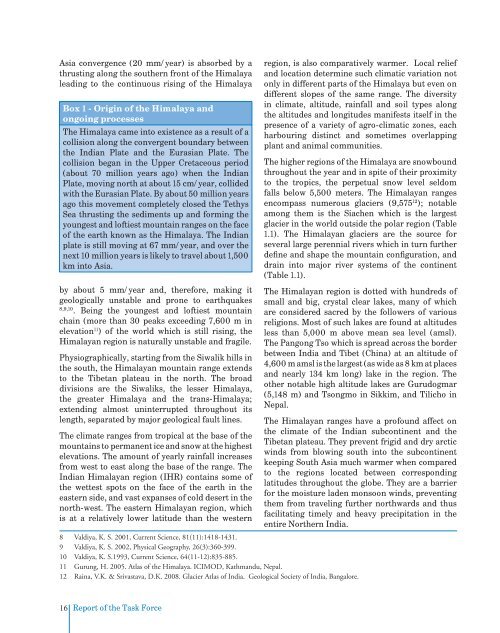Task Force Report - Govind Ballabh Pant Institute of Himalayan ...
Task Force Report - Govind Ballabh Pant Institute of Himalayan ...
Task Force Report - Govind Ballabh Pant Institute of Himalayan ...
You also want an ePaper? Increase the reach of your titles
YUMPU automatically turns print PDFs into web optimized ePapers that Google loves.
Asia convergence (20 mm/year) is absorbed by a<br />
thrusting along the southern front <strong>of</strong> the Himalaya<br />
leading to the continuous rising <strong>of</strong> the Himalaya<br />
Box 1 - Origin <strong>of</strong> the Himalaya and<br />
ongoing processes<br />
The Himalaya came into existence as a result <strong>of</strong> a<br />
collision along the convergent boundary between<br />
the Indian Plate and the Eurasian Plate. The<br />
collision began in the Upper Cretaceous period<br />
(about 70 million years ago) when the Indian<br />
Plate, moving north at about 15 cm/year, collided<br />
with the Eurasian Plate. By about 50 million years<br />
ago this movement completely closed the Tethys<br />
Sea thrusting the sediments up and forming the<br />
youngest and l<strong>of</strong>tiest mountain ranges on the face<br />
<strong>of</strong> the earth known as the Himalaya. The Indian<br />
plate is still moving at 67 mm/year, and over the<br />
next 10 million years is likely to travel about 1,500<br />
km into Asia.<br />
by about 5 mm/year and, therefore, making it<br />
geologically unstable and prone to earthquakes<br />
8,9,10<br />
. Being the youngest and l<strong>of</strong>tiest mountain<br />
chain (more than 30 peaks exceeding 7,600 m in<br />
elevation 11 ) <strong>of</strong> the world which is still rising, the<br />
<strong>Himalayan</strong> region is naturally unstable and fragile.<br />
Physiographically, starting from the Siwalik hills in<br />
the south, the <strong>Himalayan</strong> mountain range extends<br />
to the Tibetan plateau in the north. The broad<br />
divisions are the Siwaliks, the lesser Himalaya,<br />
the greater Himalaya and the trans-Himalaya;<br />
extending almost uninterrupted throughout its<br />
length, separated by major geological fault lines.<br />
The climate ranges from tropical at the base <strong>of</strong> the<br />
mountains to permanent ice and snow at the highest<br />
elevations. The amount <strong>of</strong> yearly rainfall increases<br />
from west to east along the base <strong>of</strong> the range. The<br />
Indian <strong>Himalayan</strong> region (IHR) contains some <strong>of</strong><br />
the wettest spots on the face <strong>of</strong> the earth in the<br />
eastern side, and vast expanses <strong>of</strong> cold desert in the<br />
north-west. The eastern <strong>Himalayan</strong> region, which<br />
is at a relatively lower latitude than the western<br />
region, is also comparatively warmer. Local relief<br />
and location determine such climatic variation not<br />
only in different parts <strong>of</strong> the Himalaya but even on<br />
different slopes <strong>of</strong> the same range. The diversity<br />
in climate, altitude, rainfall and soil types along<br />
the altitudes and longitudes manifests itself in the<br />
presence <strong>of</strong> a variety <strong>of</strong> agro-climatic zones, each<br />
harbouring distinct and sometimes overlapping<br />
plant and animal communities.<br />
The higher regions <strong>of</strong> the Himalaya are snowbound<br />
throughout the year and in spite <strong>of</strong> their proximity<br />
to the tropics, the perpetual snow level seldom<br />
falls below 5,500 meters. The <strong>Himalayan</strong> ranges<br />
encompass numerous glaciers (9,575 12 ); notable<br />
among them is the Siachen which is the largest<br />
glacier in the world outside the polar region (Table<br />
1.1). The <strong>Himalayan</strong> glaciers are the source for<br />
several large perennial rivers which in turn further<br />
define and shape the mountain configuration, and<br />
drain into major river systems <strong>of</strong> the continent<br />
(Table 1.1).<br />
The <strong>Himalayan</strong> region is dotted with hundreds <strong>of</strong><br />
small and big, crystal clear lakes, many <strong>of</strong> which<br />
are considered sacred by the followers <strong>of</strong> various<br />
religions. Most <strong>of</strong> such lakes are found at altitudes<br />
less than 5,000 m above mean sea level (amsl).<br />
The Pangong Tso which is spread across the border<br />
between India and Tibet (China) at an altitude <strong>of</strong><br />
4,600 m amsl is the largest (as wide as 8 km at places<br />
and nearly 134 km long) lake in the region. The<br />
other notable high altitude lakes are Gurudogmar<br />
(5,148 m) and Tsongmo in Sikkim, and Tilicho in<br />
Nepal.<br />
The <strong>Himalayan</strong> ranges have a pr<strong>of</strong>ound affect on<br />
the climate <strong>of</strong> the Indian subcontinent and the<br />
Tibetan plateau. They prevent frigid and dry arctic<br />
winds from blowing south into the subcontinent<br />
keeping South Asia much warmer when compared<br />
to the regions located between corresponding<br />
latitudes throughout the globe. They are a barrier<br />
for the moisture laden monsoon winds, preventing<br />
them from traveling further northwards and thus<br />
facilitating timely and heavy precipitation in the<br />
entire Northern India.<br />
8 Valdiya, K. S. 2001, Current Science, 81(11):1418-1431.<br />
9 Valdiya, K. S. 2002, Physical Geography, 26(3):360-399.<br />
10 Valdiya, K. S.1993, Current Science, 64(11-12):835-885.<br />
11 Gurung, H. 2005. Atlas <strong>of</strong> the Himalaya. ICIMOD, Kathmandu, Nepal.<br />
12 Raina, V.K. & Srivastava, D.K. 2008. Glacier Atlas <strong>of</strong> India. Geological Society <strong>of</strong> India, Bangalore.<br />
16<br />
<strong>Report</strong> <strong>of</strong> the <strong>Task</strong> <strong>Force</strong>

















